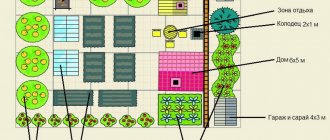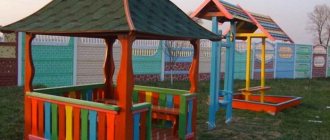Stationary poultry house
With a livestock of at least 20 individuals, you need to equip the chicken coop on a foundation. Inside, its structure differs little from the summer one, and any designs - from nests to drinking bowls - can easily be made with your own hands. The internal area is allocated at the rate of 1 m² per 5 laying hens when kept on deep litter. In this case, the space allocated for equipment is not taken into account. The enclosure is made approximately twice as spacious. Crowding leads to a decrease in egg production, in addition, laying hens can fight among themselves.
Finishing the inside of the chicken coop comes down to covering it with clapboard or OSB boards and covering them with lime mortar to prevent pests.
When planning, several important factors are taken into account:
- A winter house definitely needs a vestibule.
- The windows should face southwest; if there is too much sun in the summer, they should be shaded with curtains.
- The nests are located in the darkest and quietest area, away from the main routes of movement.
- The best site for perches is opposite the windows, away from drafts.
- It is advisable to make the roof gable, then the space under it can be used for storing equipment.
- All hens should have access to water and feeders at once. Hanging bins are placed around the perimeter of the house, mobile floor containers - anywhere, but in such a way as to avoid contamination from above.
Related article:
How to make a greenhouse with a “breadbox” design with a polycarbonate coating
Floor
Clay floors are considered optimal, while concrete floors are the worst option, with the exception of electrically heated options. For bedding, crushed hay or straw, sawdust (preferably coniferous trees), peat, and dry leaves are used. The initial layer of bulk material should be 0.15 - 0.2 m. As it becomes dirty, the litter is turned with a pitchfork to dry, and then a new portion is added.
In winter, such a floor can easily be turned into a warm one without any electricity, using the “smart” beds method. The litter is poured in a layer of at least 0.5 m and a bacterial culture is added. Straw or its analogs, mixed with droppings, begin to ferment, as a result of which the temperature in the upper layer rises to a comfortable 32°C. At the same time, bacteria destroy rotting products, improve the overall microclimate in the room and “prepare” nutritious compost for the garden. It is recommended to make bedding from pine sawdust, which has antiseptic properties. They also do not absorb moisture and laying hens feel more comfortable burrowing into them in cold weather.
Related article:
Choosing housing for a summer residence: 5 types of country houses that can be built on a plot

Ventilation
In the warm season, you can use natural ventilation by removing window frames and installing grilles instead. Or by placing small outlet openings at different heights and on opposite walls. It is even better to equip the inside of the chicken coop with a fan with a sealed lid. After ventilation, it is closed, protecting the room from drafts.
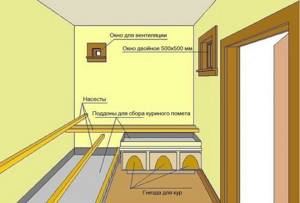
Nests, perches, drinking bowls and feeders
When arranging a chicken coop, this equipment is given priority attention. For perches , beams with a cross section of 4–6 cm are used, preferably round or at least with rounded corners. They are placed every 0.35 - 0.6 m, and the length is calculated so that each bird has at least 0.2 m. The height of the perch from the floor for small, light breeds can reach 1.2 m, for heavy ones - not more than 0.8 m.
Poultry is prone to competition, so it is undesirable to install perch poles in a “ladder” pattern - there will be a constant struggle for the top “places”. It is best to place them on the same level. To make the wood easy to clean and last longer, it is coated with an environmentally friendly water-based varnish.
Related article:
How to set up a beautiful firewood shed: 5 ideas for storing firewood in your dacha

Nests should attract birds so that they do not fly in places not intended for this purpose. Home craftsmen show amazing cunning and ingenuity using cut cans, plastic baskets for small items, vegetable boxes and even old tires.
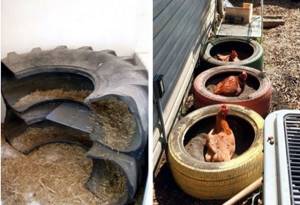
However, there can be nothing better than wooden boxes. Preference should be given to a closed structure, where the chicken feels calmer. All nests are arranged in a “line” or in several rows above each other. They try to make roofs with a slope of at least 45° so that laying hens do not sit on them and do not leave piles of droppings. The inside of the nest is lined with hay or sawdust, which is changed periodically. Before use, you need to check if there are any protruding nails or traumatic knots inside the boxes.

Sometimes a hen doesn’t like the nest for some reason and she stubbornly refuses to lay eggs in it. Then they make a “lining” - an imitation of an egg made of plaster, wood or other materials. It is important that the mass of the “counterfeit” does not exceed 60 g. You can also add an ordinary, hard-boiled egg, or even better, a shell that has retained its shape, into which paraffin or gypsum solution has been poured.
Related article:
Do-it-yourself cellar for storing vegetables
It will not be difficult for craftsmen to equip a poultry house with their own hands with a convenient nest with an egg collector. In this case, the bottom inside the box is made inclined:

This video will tell you about such wonderful homemade products for a chicken coop, such as drinkers and feeders:
Additional capacities
In addition to the main feeders, small boxes (about 0.1 x 0.4 m) are attached at a height of 0.15 - 0.2 m from the floor, which should always contain: shells, chalk and fine gravel, and even better - quartz or granite grains , with a diameter of no more than 5 mm. The first two additives replenish the diet of laying hens with much-needed calcium, and the latter is needed for crushing roughage inside the intestines. You can use river sand, including gravel fractions. Without this supplement, undigested food will irritate and damage the walls of the cloaca, which in turn will lead to cannibalism.
For dry bathing you need a bath with wood ash. In it, laying hens are cleaned of external parasites. It is recommended to mix ash with fine dry sand or road dust in a 1:1 ratio. The size of the bath can vary and can reach 1 m in large rooms. It is advisable that the diet of laying hens also include charcoal, which gets rid of internal parasites and also helps remove toxins.
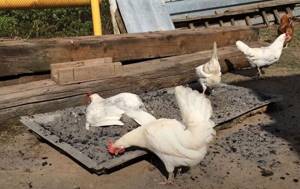
Summer poultry house
For summer residents who have never been involved in poultry farming and don’t even really know what a chicken coop looks like, it is better to start with seasonal breeding. A few laying hens will be quite enough to gain first experience and “get the hang of it.” In this case, you can just make a summer chicken coop, something like this:
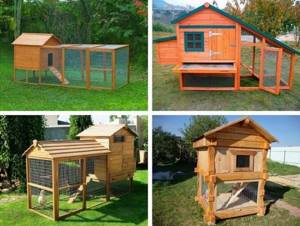
Portable poultry houses are placed on high supports - real “huts on chicken legs”. Walking is carried out not only in the attached enclosure, but also under the house, which also serves as a canopy from the sun or rain. The dimensions of a standard poultry house in terms of 1.5x2 m, height - about 1.5 m. The length of the supports should be at least 0.4 m, but it is better to increase this value to make cleaning more convenient.
Related article:
Organizing space for country tools: 6 great storage ideas
An example of arranging a country chicken coop with your own hands
The poultry house is quite large - 1.7 x 2.5 m in plan. The length together with the extension aviary is 5 m. The walls are made of OSB boards on a wooden frame. The height of the supports is 0.65 m. Due to the fact that the house is raised above the ground, the floor will remain dry even during spring floods, and it will be more difficult for mice and rats to get inside. At the same time, light laying hens can easily fly down even without a ladder, although a similar device is also provided.

The room is designed for 12 hens and 1 rooster. In the side of the house there is a hole with a cross-section of 0.3x0.4 m, it is intended for small breeds, such as Russian Whites or Leghorns. For massive crosses, the “window” will have to be increased to 0.4x0.45 m. The hole is not located near the floor, since high litter will spill out of it, and the laying hens will have to literally squeeze into the gap. The optimal distance between the bottom of the hole and the base plate is at least 0.1 m. The hole must be hermetically sealed.
Related article:
We provide maximum comfort and convenience of country life: 6 buildings in the country that you can’t do without
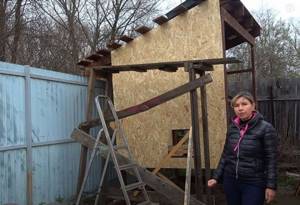
When making a chicken coop at the dacha for a warm winter, the walls are assembled from double slabs, like a sandwich, inside which polystyrene foam, 0.1 m thick, is placed. There should be no access to the insulation from the inside, otherwise the chickens will peck at it. It is more convenient and correct to make a pitched roof. A plywood deck is attached to the rafters, then a layer of waterproofing is applied, and slate sheets or, in a luxurious version, soft tiles are laid on top.
Using this drawing, it’s easy to make a chicken coop with your own hands:

The plank floor is laid along joists. From below, the entire structure must be impregnated with bitumen. Between the joists you can put insulation - still the same polystyrene foam.
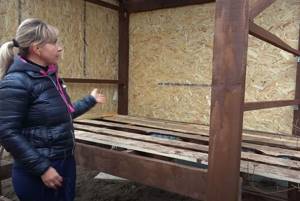
The extension is also built under a pitched roof. The section of the fencing mesh is 2x2.5 cm.

If you make the front door glazed, you can save on the window.
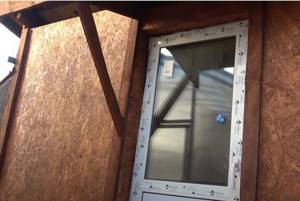
Summer poultry houses are characterized by the installation of feeders and drinkers in the open air. However, if the house is planned to be used in winter, they are brought inside.
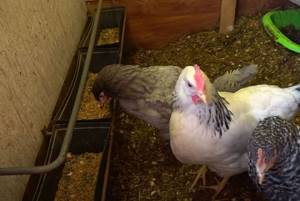
Nipple drinkers ensure that no debris gets into the water and that it is clean, which is important for the health of laying hens. In addition, lovers of spontaneous bathing will not be able to spill anything.
Related article:
How to disguise a compost pit?
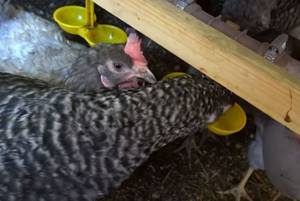
How to make an autonomous drinking bowl for chickens: video
A perch with a tray covered with a metal mesh is just what you need for a home chicken coop. The bird does not walk on its own droppings and does not get dirty; the litter on the floor remains clean. And valuable fertilizer is easily removed from the pull-out tray and sent straight to the compost pit. A convenient ladder leads to the perch.

On the wall, almost under the ceiling, there are timers that turn on the light and heater during the cold season.

Remote sockets
In mini-poultry houses that are not designed for extreme frosts, the nests are made remote. This allows you to collect eggs and clean up without disturbing the hens as much as possible. In addition, space inside the houses is saved. This design is not suitable for winter cold, since when opened, a flow of cold air will enter inside.
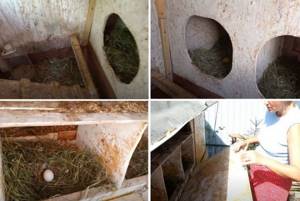
One standard nest is designed for 5 laying hens. It is a wooden box 0.3x0.3 m, about 0.25 m high. The entrance is also cut 0.25 m wide and a threshold of 5 cm must be installed. A shelf for take-off must be attached in front of the nest. For remote structures, the box is located not inside, but outside the room for laying hens, and the back wall is hinged. Otherwise, the socket structure is no different from the standard one.
Related article:
Simple fences for a summer residence: 5 best ideas that everyone can do

